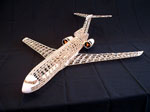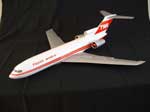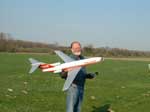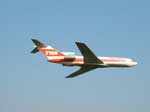



click on the picture for a larger image
BOEING 727/100
BOEING 727/100 for GWS Twin EDF-50
By DA Ramsey
My first experience, with the GWS EDF-50, was with my Learjet23. This aircraft was a thread in this forum last year and was published in the March 2004 issue of Flying Models Magazine. After many flights - the motors have been flown over 3 hours - I could see that much of their power was wasted overcoming the drag of the flat bottomed wing. The Learjet was a lovely flyer, but it could fly faster with a different airfoil. The other factor that seemed to work well for the twin EDF-50s was, a wing area of 1.5 sq. ft. and an overall weight of 12 ounces for a wing loading of under 8 ounces.
With this in mind I began researching the 727. My primary tool for engineering the design was a Hasegawa 1/200 scale, Boeing 727/200 plastic kit. To save a little fuselage weight, I chose the 727/100. The wing and stab have an increase in area of around 15% from slight enlargements to root and tip cords and increased wing span. The wing tip ailerons are 2 X scale.
The airfoil and wing were designed using CompuFoil 2000. I call it a 9% Clark "Yish". CompuFoil was also very handy in laying out the stab and fin.
The first flight was only intended as a test glide. As the grass was short, I got down on my knees, to get closer to the ground, applied about ¼ power and gave it a light toss. Well it just sailed off in ground effect. Only thing to do was add power. The sight of my 727's silhouette flying through the setting sun really warmed my heart.
I'd estimate the 727's top speed to be three time greater than my Learjet. She will maintain altitude at 1/3 power with positive aileron response. During the first 5 minutes of flight, from a freshly charged battery, she will do very nice loops with a high speed, full power entry. Rolls, while not the prettiest, are always completed. While the 727 handles breezes better than the Learjet, the most enjoyable flights are in calm conditions.
Landings are painless as she glides like a sail plane.
The article and plans will be published in Flying Models Magazine. Not sure of date yet.
Specifications:
Weight: Just over 12 ounces
Wing span: 45"
Length: 49"
Effective wing area: 1.59 sq. ft.
Wing loading: 7.86 oz. per sq. ft.
Controls: Ailerons, flying stab and throttle
Construction: Balsa
Covering and graphics: SoLite
Motors: Twin GWS EDF-50s using CN12-R-LC motors with 2020x3 fans 6.5A total static draw. 3.5" paper tail tubes with exit diameter reduced to 1.563"
ESC: CC Pixie 7P
Battery: Kokam 2s, 1500mAh Lipoly
Servos: 2 GWS Pico BB
RX: Berg 5
Battery performance: I currently fly 6, 5 minute flights at mostly ½ power, with 5 minute rest periods.
TX & RX remain ON for 1 hour.